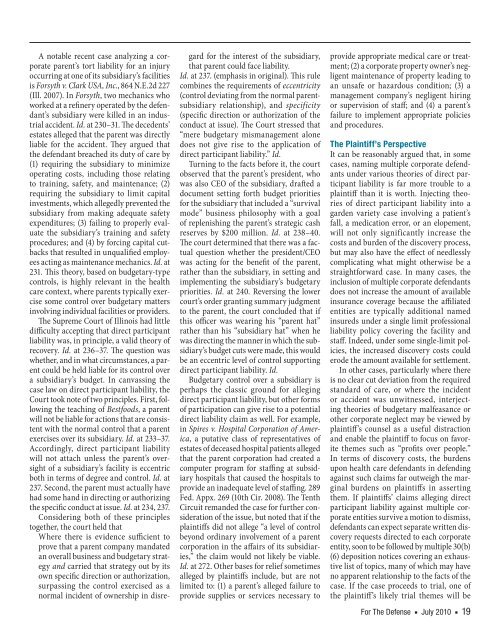For The Defense, July 2010 - DRI Today
For The Defense, July 2010 - DRI Today
For The Defense, July 2010 - DRI Today
- No tags were found...
You also want an ePaper? Increase the reach of your titles
YUMPU automatically turns print PDFs into web optimized ePapers that Google loves.
A notable recent case analyzing a corporateparent’s tort liability for an injuryoccurring at one of its subsidiary’s facilitiesis <strong>For</strong>syth v. Clark USA, Inc., 864 N.E.2d 227(Ill. 2007). In <strong>For</strong>syth, two mechanics whoworked at a refinery operated by the defendant’ssubsidiary were killed in an industrialaccident. Id. at 230–31. <strong>The</strong> decedents’estates alleged that the parent was directlyliable for the accident. <strong>The</strong>y argued thatthe defendant breached its duty of care by(1) requiring the subsidiary to minimizeoperating costs, including those relatingto training, safety, and maintenance; (2)requiring the subsidiary to limit capitalinvestments, which allegedly prevented thesubsidiary from making adequate safetyexpenditures; (3) failing to properly evaluatethe subsidiary’s training and safetyprocedures; and (4) by forcing capital cutbacksthat resulted in unqualified employeesacting as maintenance mechanics. Id. at231. This theory, based on budgetary- typecontrols, is highly relevant in the healthcare context, where parents typically exercisesome control over budgetary mattersinvolving individual facilities or providers.<strong>The</strong> Supreme Court of Illinois had littledifficulty accepting that direct participantliability was, in principle, a valid theory ofrecovery. Id. at 236–37. <strong>The</strong> question waswhether, and in what circumstances, a parentcould be held liable for its control overa subsidiary’s budget. In canvassing thecase law on direct participant liability, theCourt took note of two principles. First, followingthe teaching of Bestfoods, a parentwill not be liable for actions that are consistentwith the normal control that a parentexercises over its subsidiary. Id. at 233–37.Accordingly, direct participant liabilitywill not attach unless the parent’s oversightof a subsidiary’s facility is eccentricboth in terms of degree and control. Id. at237. Second, the parent must actually havehad some hand in directing or authorizingthe specific conduct at issue. Id. at 234, 237.Considering both of these principlestogether, the court held thatWhere there is evidence sufficient toprove that a parent company mandatedan overall business and budgetary strategyand carried that strategy out by itsown specific direction or authorization,surpassing the control exercised as anormal incident of ownership in disregardfor the interest of the subsidiary,that parent could face liability.Id. at 237. (emphasis in original). This rulecombines the requirements of eccentricity(control deviating from the normal parentsubsidiaryrelationship), and specificity(specific direction or authorization of theconduct at issue). <strong>The</strong> Court stressed that“mere budgetary mismanagement alonedoes not give rise to the application ofdirect participant liability.” Id.Turning to the facts before it, the courtobserved that the parent’s president, whowas also CEO of the subsidiary, drafted adocument setting forth budget prioritiesfor the subsidiary that included a “survivalmode” business philosophy with a goalof replenishing the parent’s strategic cashreserves by $200 million. Id. at 238–40.<strong>The</strong> court determined that there was a factualquestion whether the president/CEOwas acting for the benefit of the parent,rather than the subsidiary, in setting andimplementing the subsidiary’s budgetarypriorities. Id. at 240. Reversing the lowercourt’s order granting summary judgmentto the parent, the court concluded that ifthis officer was wearing his “parent hat”rather than his “subsidiary hat” when hewas directing the manner in which the subsidiary’sbudget cuts were made, this wouldbe an eccentric level of control supportingdirect participant liability. Id.Budgetary control over a subsidiary isperhaps the classic ground for allegingdirect participant liability, but other formsof participation can give rise to a potentialdirect liability claim as well. <strong>For</strong> example,in Spires v. Hospital Corporation of America,a putative class of representatives ofestates of deceased hospital patients allegedthat the parent corporation had created acomputer program for staffing at subsidiaryhospitals that caused the hospitals toprovide an inadequate level of staffing. 289Fed. Appx. 269 (10th Cir. 2008). <strong>The</strong> TenthCircuit remanded the case for further considerationof the issue, but noted that if theplaintiffs did not allege “a level of controlbeyond ordinary involvement of a parentcorporation in the affairs of its subsidiaries,”the claim would not likely be viable.Id. at 272. Other bases for relief sometimesalleged by plaintiffs include, but are notlimited to: (1) a parent’s alleged failure toprovide supplies or services necessary toprovide appropriate medical care or treatment;(2) a corporate property owner’s negligentmaintenance of property leading toan unsafe or hazardous condition; (3) amanagement company’s negligent hiringor supervision of staff; and (4) a parent’sfailure to implement appropriate policiesand procedures.<strong>The</strong> Plaintiff’s PerspectiveIt can be reasonably argued that, in somecases, naming multiple corporate defendantsunder various theories of direct participantliability is far more trouble to aplaintiff than it is worth. Injecting theoriesof direct participant liability into agarden variety case involving a patient’sfall, a medication error, or an elopement,will not only significantly increase thecosts and burden of the discovery process,but may also have the effect of needlesslycomplicating what might otherwise be astraightforward case. In many cases, theinclusion of multiple corporate defendantsdoes not increase the amount of availableinsurance coverage because the affiliatedentities are typically additional namedinsureds under a single limit professionalliability policy covering the facility andstaff. Indeed, under some single- limit policies,the increased discovery costs coulderode the amount available for settlement.In other cases, particularly where thereis no clear cut deviation from the requiredstandard of care, or where the incidentor accident was unwitnessed, interjectingtheories of budgetary malfeasance orother corporate neglect may be viewed byplaintiff’s counsel as a useful distractionand enable the plaintiff to focus on favoritethemes such as “profits over people.”In terms of discovery costs, the burdensupon health care defendants in defendingagainst such claims far outweigh the marginalburdens on plaintiffs in assertingthem. If plaintiffs’ claims alleging directparticipant liability against multiple corporateentities survive a motion to dismiss,defendants can expect separate written discoveryrequests directed to each corporateentity, soon to be followed by multiple 30(b)(6) deposition notices covering an exhaustivelist of topics, many of which may haveno apparent relationship to the facts of thecase. If the case proceeds to trial, one ofthe plaintiff’s likely trial themes will be<strong>For</strong> <strong>The</strong> <strong>Defense</strong> n <strong>July</strong> <strong>2010</strong> n 19
















